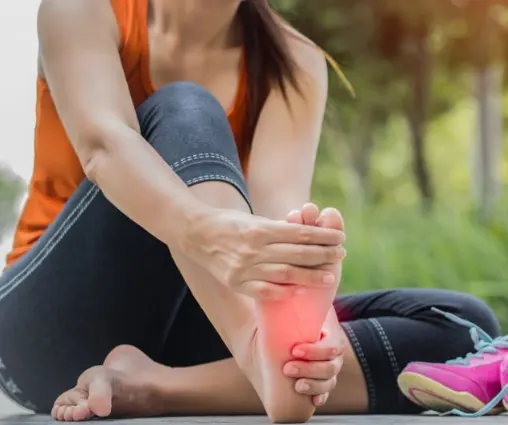Cold weather can lead to foot pain in so many ways. We’ve already talked about your increased risk for trips, falls and ankle injuries in the winter. But today we want to focus on pain, and how to keep dropping temperatures from hurting your feet.
Cold temperatures cause muscles and tissues within our joints to tighten. As the tissues contract, they pull on the nerve endings causing pain in our joints.
When it’s cold outside, staying indoors is more inviting. Often, that means skipping out on supportive running shoes or boots in favor of slippers or bare feet. Now, this may be cozy, but it puts much more pressure on the connective tissues in your feet. As a result, they may become inflamed. And that’s when you may develop the heel pain of plantar fasciitis. Plantar fasciitis can also develop due to tight calf muscles or ill-fitting boots leading to injury of the plantar fascia and inflammation.
Of course, that’s not the only risk we face when it comes to cold weather foot pain. As temperatures drop, your body experiences reduced circulation and your joints and muscle can contract so symptoms of arthritis may be worse during the long winter months.
Also, if you do venture outside and pick the wrong socks or winter boots, your feet may get damp from snow and rain. (Or sweaty from all the layers you’ve put on trying to stay warm.) Either way, trapped moisture around your feet ups your risk for fungal infections such as Athlete’s foot.
Finally, symptoms of Raynaud’s disease become apparent during the winter. The symptoms of Raynaud’s disease occur when the small arteries that supply blood to your skin become narrow, reducing blood flow to your affected areas. Without proper precautions, you may develop painful symptoms in your hands and feet, even after spending just a few minutes in the cold.
As an experienced podiatrist in Westfield, Carmel, Noblesville, Fishers and Zionsville, IN, Dr. David Sullivan is quite familiar with cold weather foot pain. He knows that the best way to beat discomfort is to take preventative measures.
First, wear supportive shoes, even when you’re stuck at home. And try to stick to a regular exercise routine, to keep your muscles and joints loose and limber. Regular stretching can also help keep pain away. Always choose weather-appropriate footwear (and outerwear) and be sure to change damp socks as soon as possible.
If you suffer from arthritis, drinking warm liquids such as tea, water and bone broth can improve circulation and lessen arthritis in the feet and ankles.









